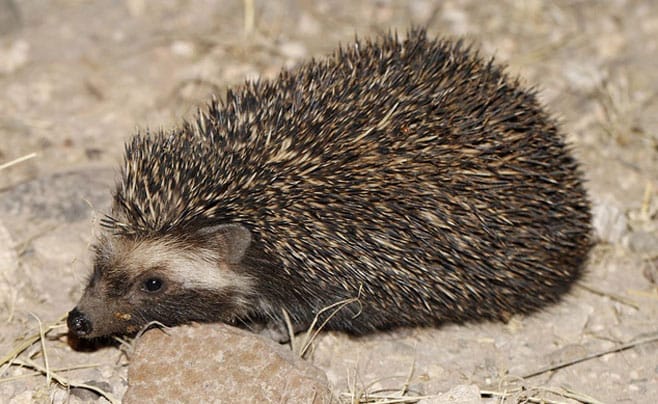If you cannot find the answer you are looking for, please contact us.
Somali hedgehog

Discovered and described in 1895 by Oldfield Thomas. It is found only in Somalia and Ethiopia, making it geographically isolated from all other hedgehog species. It is distinguished by its pale facial fur combined with a darker base to the ears.
Taxonomy
| Kingdom: | Animalia |
| Phylum: | Chordata |
| Class: | Mammalia |
| Order: | Eulipotyphla |
| Family: | Erinaceidae |
| Genus: | Atelerix |
| Species: | Atelerix sclateri |
Natural range & habitat
The Somali Hedgehog is endemic to the Horn of Africa, with a range that is restricted primarily to Somalia and potentially parts of eastern Ethiopia. Due to regional instability and limited field research, the full extent of its distribution remains poorly defined. This species is thought to inhabit dry savannah, shrublands, and semi-arid environments with scattered vegetation. It likely prefers areas that offer a mix of open ground for foraging and denser patches for daytime shelter. Detailed habitat studies are lacking, so further investigation is needed to understand its specific preferences, seasonal movements, and microhabitat use.
Physical traits
The Somali Hedgehog is a small to medium-sized species within its genus. It has a compact, rounded body covered in dense spines on its back and flanks, while the belly is furred and softer. The coloration is generally pale to sandy-brown, with very dark color in the face and spines, which may serve as camouflage in the arid landscapes it inhabits. It has a relatively short snout and prominent dark eyes. Its ears are medium-sized and rounded, and it possesses strong limbs with curved claws adapted for digging. More detailed observations of live individuals are needed to confirm adult weight, average length, and variability within the species. A lot is unknown due to limited research.
Behavior & lifestyle
Like most hedgehogs, the Somali Hedgehog is believed to be nocturnal and solitary, with peak activity during the cooler hours of the night. Its behavior in the wild is largely undocumented, but it likely follows patterns observed in closely related species such as the African pygmy hedgehog, the cosest known relative to the species. It is assumed to rest during the day in self-dug burrows, under vegetation, or in abandoned animal dens. Foraging likely involves slow, methodical movement through underbrush or open ground, guided by its acute sense of smell. There is no current data on its home range size, interactions with conspecifics, or seasonal changes in behavior, though it may engage in shallow torpor during extreme environmental conditions.
Communication
Specific information about communication in the Somali Hedgehog is unavailable. Based on its taxonomic relationship to other Atelerix species, it likely uses a combination of olfactory cues and limited vocalizations to communicate. Scent marking through feces and urine may play a role in defining territory or signaling reproductive status. Audible cues such as huffs or grunts may be used in courtship or as a warning, but these have not been observed directly in this species. Self-anointing behavior has not yet been reported but may occur given its presence in related hedgehogs.
Diet in the wild
The diet of the Somali Hedgehog has not been formally studied. However, as an insectivore from a dry habitat, it most likely consumes a wide variety of invertebrates, including beetles, ants, termites, caterpillars, and possibly small vertebrates such as lizards or amphibians when available. Seasonal shifts in prey abundance may influence dietary composition. Like other hedgehogs, it may also opportunistically eat fallen fruit or carrion, especially in times of scarcity. Further research is needed to determine exact feeding preferences, digestive adaptations, and the role of water acquisition from prey.
Reproduction & life cycle
There is currently no published data on the reproductive cycle of the Somali Hedgehog. It is presumed to follow a seasonal breeding pattern influenced by rainfall and resource availability, as seen in other African hedgehogs. Mating behavior, gestation period, litter size, and maternal care are undocumented. In closely related species, gestation typically lasts around 30 to 40 days, with litters of 2 to 6 young born in hidden nests. It is not known whether the Somali Hedgehog produces multiple litters per year or exhibits reproductive dormancy during dry seasons. Studies on captive breeding or wild population monitoring could greatly enhance our understanding of its reproductive biology.
Threats & conservation status
The Somali Hedgehog is listed as Data Deficient by the IUCN Red List due to a lack of detailed information on its distribution, population size, and ecological needs. Habitat degradation, particularly through overgrazing, desertification, and human encroachment, may pose a threat. However, the true impact of these factors is unknown. Political instability and limited access to its native range have severely hampered field research. No specific conservation actions are currently in place, and the species does not appear to be included in any protected area management plans. It is not known whether the Somali Hedgehog is hunted locally or affected by the illegal pet trade. Ongoing habitat monitoring and baseline population surveys are urgently needed.
This species in captivity
There is no known population of Somali Hedgehogs in captivity, either in the pet trade or in zoological institutions. The species is not bred in captivity, and its husbandry requirements remain speculative. Given its presumed similarity to the African pygmy hedgehog, it may require warm, dry conditions, access to hiding spaces, and a diet rich in invertebrates. However, without data on stress tolerance, social behavior, or environmental triggers, captivity is likely to pose significant welfare challenges. The absence of this species in managed breeding programs makes it vulnerable to unmonitored decline in the wild. If future conservation or education programs seek to include this species, field-based ecological data will be essential for success.
